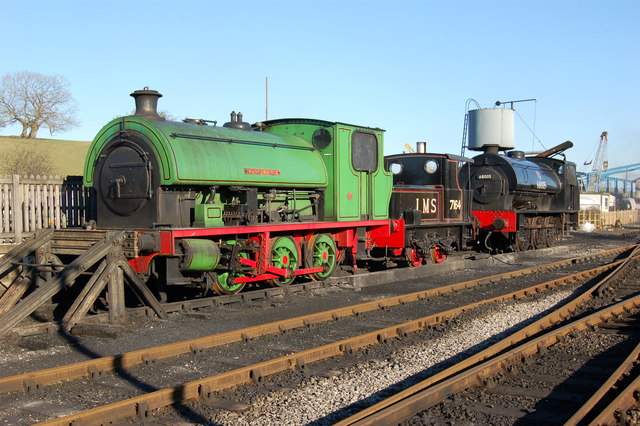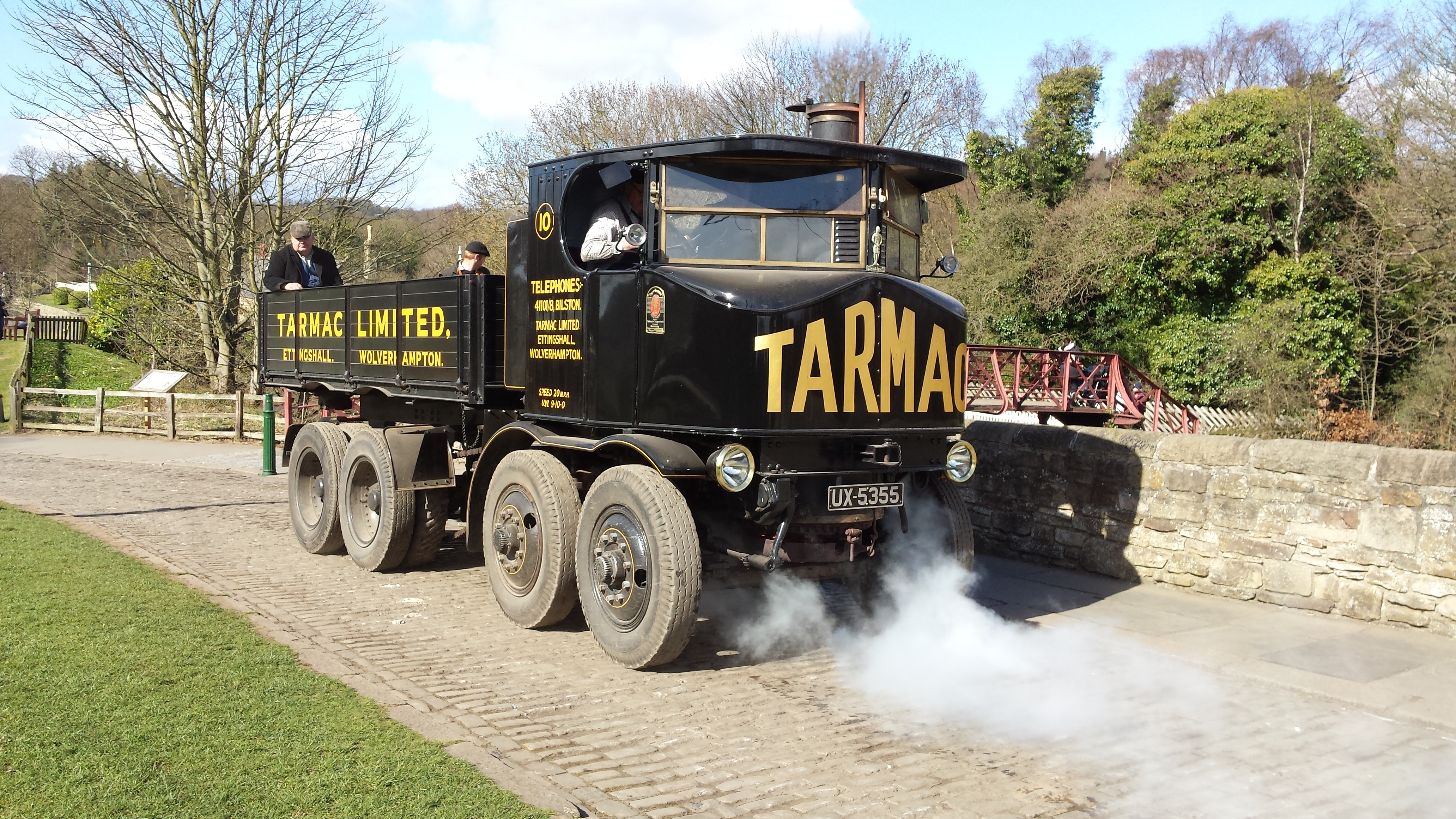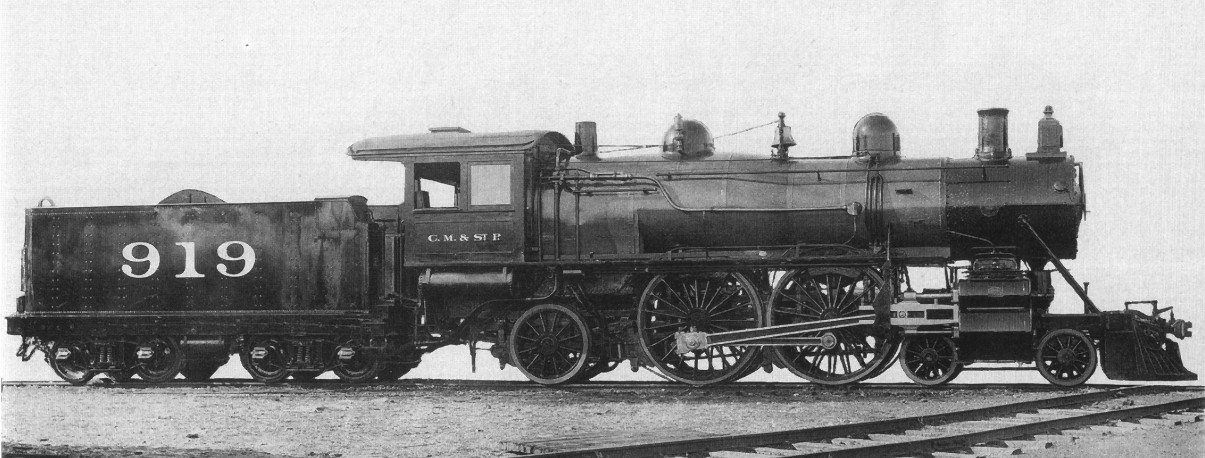|
LMS Sentinel 7164
The London, Midland and Scottish Railway (LMS) Sentinel No. 7164, (later 7184 and under British Railways, 47184) was a small shunting locomotive. Its design was that of the single-speed Sentinel, a vertical-boilered geared locomotive, using Sentinel's standard vertical boiler and steam motor design. This was the smallest of the four Sentinel classes used by the LMS. Design 7164 was the LMS' only example of the early Sentinel BE or 'Balanced Engine' design, rather than the later CE or 'Central Engine' design used for 7160-7163. This placed the boiler and engine at opposite ends of the frames, with the water tank in the centre. Although the LNER Class Y1 Sentinel was also a single-speed, they were of the larger Central Engine design and were similar to the two-speed locomotives in appearance. Service Built in 1931 by Sentinel Waggon Works as Works No. 8593, it was taken into LMS stock in 1932 as 7164. It was to a design that was also built for use industry, but unique within ... [...More Info...] [...Related Items...] OR: [Wikipedia] [Google] [Baidu] |
Sentinel Waggon Works
Sentinel Waggon Works Ltd was a British company based in Shrewsbury, Shropshire that made steam-powered lorries (steam wagons), railway locomotives, and later, diesel engined lorries, buses and locomotives. History Alley & MacLellan, Sentinel Works, Jessie Street Glasgow Alley & MacLellan was founded in 1875 and was based in Polmadie, Glasgow. This company continued in operation until the 1950s. Initially manufacturing valves and compressors for steam engines, and later whole steamships, Alley & MacLellan acquired Simpson and Bibby of Horsehay, Shropshire, manufacturer of steam-powered road vehicles, in 1903. They began producing steam road vehicles in 1905 and in 1906 introduced a five-ton vertical-boiler steam wagon, which featured a two-cylinder undertype engine and chain drive. Around 1915, Alley & McLellan moved the steam wagon production to a new factory to Shrewsbury and it continued under a separate company (see below), and in 1918 the company also opened a th ... [...More Info...] [...Related Items...] OR: [Wikipedia] [Google] [Baidu] |
Radstock
Radstock is a town and civil parish on the northern slope of the Mendip Hills in Somerset, England, about south-west of Bath and north-west of Frome. It is within the area of the unitary authority of Bath and North East Somerset. The Radstock built-up area had a population of 9,419 at the 2011 Census. Radstock has been settled since the Iron Age, and its importance grew after the construction of the Fosse Way, a Roman road. The town grew after 1763, when coal was discovered in the area. Large numbers of mines opened during the 19th century, including several owned by the Waldegrave family, who had been Lords of the Manor since the Civil War. Admiral Lord Radstock, brother of George, fourth Earl Waldegrave, took the town's name as his title when created a Baron. The spoil heap of Writhlington colliery is now the Writhlington Site of Special Scientific Interest, which includes 3,000 tons of Upper Carboniferous spoil from which more than 1,400 insect fossil specim ... [...More Info...] [...Related Items...] OR: [Wikipedia] [Google] [Baidu] |
Railway Locomotives Introduced In 1931
Rail transport (also known as train transport) is a means of transport that transfers passengers and goods on wheeled vehicles running on rails, which are incorporated in tracks. In contrast to road transport, where the vehicles run on a prepared flat surface, rail vehicles (rolling stock) are directionally guided by the tracks on which they run. Tracks usually consist of steel rails, installed on sleepers (ties) set in ballast, on which the rolling stock, usually fitted with metal wheels, moves. Other variations are also possible, such as "slab track", in which the rails are fastened to a concrete foundation resting on a prepared subsurface. Rolling stock in a rail transport system generally encounters lower frictional resistance than rubber-tyred road vehicles, so passenger and freight cars (carriages and wagons) can be coupled into longer trains. The operation is carried out by a railway company, providing transport between train stations or freight customer facil ... [...More Info...] [...Related Items...] OR: [Wikipedia] [Google] [Baidu] |
Standard Gauge Steam Locomotives Of Great Britain
Standard may refer to: Symbols * Colours, standards and guidons, kinds of military signs * Standard (emblem), a type of a large symbol or emblem used for identification Norms, conventions or requirements * Standard (metrology), an object that bears a defined relationship to a unit of measure used for calibration of measuring devices * Standard (timber unit), an obsolete measure of timber used in trade * Breed standard (also called bench standard), in animal fancy and animal husbandry * BioCompute Standard, a standard for next generation sequencing * ''De facto'' standard, product or system with market dominance * Gold standard, a monetary system based on gold; also used metaphorically for the best of several options, against which the others are measured * Internet Standard, a specification ratified as an open standard by the Internet Engineering Task Force * Learning standards, standards applied to education content * Standard displacement, a naval term describing the weig ... [...More Info...] [...Related Items...] OR: [Wikipedia] [Google] [Baidu] |
Individual Locomotives Of Great Britain
An individual is that which exists as a distinct entity. Individuality (or self-hood) is the state or quality of being an individual; particularly (in the case of humans) of being a person unique from other people and possessing one's own needs or goals, rights and responsibilities. The concept of an individual features in diverse fields, including biology, law, and philosophy. Etymology From the 15th century and earlier (and also today within the fields of statistics and metaphysics) ''individual'' meant " indivisible", typically describing any numerically singular thing, but sometimes meaning "a person". From the 17th century on, ''individual'' has indicated separateness, as in individualism. Law Although individuality and individualism are commonly considered to mature with age/time and experience/wealth, a sane adult human being is usually considered by the state as an "individual person" in law, even if the person denies individual culpability ("I followed instruct ... [...More Info...] [...Related Items...] OR: [Wikipedia] [Google] [Baidu] |
Sentinel Locomotives
Sentinel may refer to: Places Mountains * Mount Sentinel, a mountain next to the University of Montana in Missoula, Montana * Sentinel Buttress, a volcanic crag on James Ross Island, Antarctica * Sentinel Dome, a naturally occurring granite dome in Yosemite National Park, California * Sentinel Mountain (Montana), in Glacier National Park * Sentinel Peak (Alberta) * Sentinel Peak (Antarctica) * Sentinel Peak (Arizona), a peak in the Tucson Mountains * Sentinel Peak (British Columbia) * Sentinel Range, a mountain range in Antarctica * The Sentinel, Hout Bay * The Sentinel (Zion), a sandstone summit in Zion National Park, Utah Elsewhere * Sentinel, Arizona * Sentinel, California * Sentinel, Missouri * Sentinel, Oklahoma * Sentinel Island (other) Arts, entertainment, and media Artworks * ''Sentinel'' (sculpture), a 2000 sculpture by Tim Tolkien * ''Sentinels'' (Hudson), a 2005 public artwork by American artist Jon Barlow Hudson Comics * ''Sentinel'' (c ... [...More Info...] [...Related Items...] OR: [Wikipedia] [Google] [Baidu] |
At Rest - Geograph
AT or at may refer to: Geography Austria * Austria (ISO 2-letter country code) * .at, Internet country code top-level domain United States * Atchison County, Kansas (county code) * The Appalachian Trail (A.T.), a 2,180+ mile long mountainous trail in the Eastern United States Elsewhere * Anguilla (World Meteorological Organization country code) * Ashmore and Cartier Islands (FIPS 10-4 territory code, and obsolete NATO country code) * At, Bihar, village in Aurangabad district of Bihar, India * Province of Asti, Italy (ISO 3166-2:IT code) Science and technology Computing * @ (or "at sign"), the punctuation symbol now typically used in e-mail addresses and tweets) * at (command), used to schedule tasks or other commands to be performed or run at a certain time * IBM Personal Computer/AT ** AT (form factor) for motherboards and computer cases ** AT connector, a five-pin DIN connector for a keyboard * The Hayes command set for computer modems (each command begins with the ... [...More Info...] [...Related Items...] OR: [Wikipedia] [Google] [Baidu] |
Compound Steam Locomotive
A compound locomotive is a steam locomotive which is powered by a compound engine, a type of steam engine where steam is expanded in two or more stages. The locomotive was only one application of compounding. Two and three stages were used in ships, for example. Compounding became popular for railway locomotives from the early 1880s and by the 1890s were becoming common. Large numbers were constructed, mostly two- and four-cylinder compounds, in France, Germany, Austria, Hungary, and the United States. It declined in popularity due to maintenance issues and because superheating provided similar efficiencies at lower cost. Nonetheless, compound Mallets were built by the Norfolk and Western Railway right up to 1952. Introduction In the usual arrangement for a compound engine the steam is first expanded in one or two high-pressure ''(HP)'' cylinders, then having given up some heat and lost some pressure, it exhausts into a larger-volume low-pressure ''(LP)'' cylinder, (or two, - ... [...More Info...] [...Related Items...] OR: [Wikipedia] [Google] [Baidu] |
Abner Doble
Abner Doble (March 26, 1890 – July 16, 1961) was an American mechanical engineer who built and sold steam-powered automobiles as Doble Steam Cars. His steam engine design was used in various automobiles from the early 1900s, including a 1969 General Motors prototype and the first successful steam-powered aeroplane. Family history Doble was born on March 26, 1890, in San Francisco, one of four brothers. His father was William Ashton Doble, son of the inventor of the Doble water wheel. Doble's forebears had migrated from England to the US in the mid-1700s. William's father Abner was born in Indiana. He had been a sailor, a smith, and a lumberman, who became a journeyman blacksmith and subsequently became partner in Nelson and Doble. The company became one of the biggest manufacturers of miner's and blacksmith's tools on the US Pacific coast during the California Gold Rush. The company became famous manufacturing Abner Doble's water wheel turbines for mining applications. Th ... [...More Info...] [...Related Items...] OR: [Wikipedia] [Google] [Baidu] |
LMS Sentinel 7192
The London, Midland and Scottish Railway (LMS) Sentinel No. 7192 was a geared steam locomotive. It was built in 1934 by the Sentinel Waggon Works of Shrewsbury, maker's number 8805 on LMS Lot 111. It had an Abner Doble boiler combined with a 4-cylinder compound Compound may refer to: Architecture and built environments * Compound (enclosure), a cluster of buildings having a shared purpose, usually inside a fence or wall ** Compound (fortification), a version of the above fortified with defensive struct ... arrangement, but an order for an additional locomotive and three railcars to a similar was later cancelled. It was withdrawn in 1963 and scrapped. References * 0F 0-4-0T locomotives Sentinel locomotives Compound locomotives Railway locomotives introduced in 1934 Standard gauge steam locomotives of Great Britain Scrapped locomotives {{UK-steam-loco-stub Individual locomotives of Great Britain Shunting locomotives ... [...More Info...] [...Related Items...] OR: [Wikipedia] [Google] [Baidu] |




